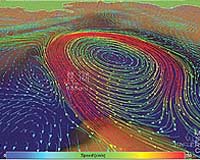| . |  |
. |
Washington (AFP) June 7, 2010 The long-term effects of the Gulf of Mexico oil spill will damage fragile ecosystems for years to come, US officials said Monday, as engineers successfully captured more crude from a broken wellhead. "Dealing with the oil spill on the surface will go on for a couple of months," said Admiral Thad Allen, who is coordinating the government's response to what has been called the worst environmental catastrophe in US history. "Long term issues of restoring environments and habitats and stuff will be years," he added after briefing President Barack Obama on the latest developments in the disaster. At least 20 million gallons of oil has spilled into the sea since an April 20 explosion tore through the Deepwater Horizon rig, and is now contaminating miles of the Louisiana coastline threatening rare birds and wildlife. BP said Monday it had spent at least 1.25 billion dollars on the Gulf of Mexico oil spill as it continued its efforts to contain the leak, threatening other neighboring states, including the Florida beaches. "We have gone from 6,000 to 11,000" barrels a day, said Allen, referring to a containment cap put in place last week to cover the leaking pipe a mile (1,600 meters) down on the sea floor. A tube is now siphoning the leaking oil up to a containment ship on the surface, and BP was "trying to increase that production rate, close the venting valves and move to a greater capacity," he added. But he would not be drawn on what percentage of the oil pouring from the fractured wellhead was now being contained, and warned that "there will be long-term environmental issues" which would need careful assessment. "We'll get the actual flow rate established," Allen vowed. "We have two models for flow out of the wellhead done under the US Geological Survey. One was a range of 12,000 to 19,000 barrels a day. The other was 12,000 to 25,000 barrels a day." He said engineers soon hoped to be capturing 15,000 barrels a day, which would then help calculate precisely how much is still flowing into the sea. "Optimization continues and improvement in oil collection is expected over the next several days," the British energy giant said in a statement. "It will be a few days before an assessment can be made as to the success of this containment effort." The oil has already forced the closure of valuable fishing grounds, blighting the livelihoods of many residents. And hundreds of birds have been picked up by wildlife rescue workers in coastal states -- including Alabama, Florida and Mississippi. Of the 820 birds found so far, 597 have been dead, and all 223 found alive have been visibly oiled, officials said. For the first time, oiled birds showed up in Texas. Among them are the brown pelican -- the Louisiana state symbol, which was only removed from the endangered list in November. BP said it had already spent 1.25 billion dollars on efforts to contain the spill, but that does not include 360 million dollars earmarked to build artificial barrier islands to protect the Louisiana coastline. So far, there are no signs of the oil in southern Florida, but experts said the edges of massive oil plumes were reaching the Loop Current and even the Gulf Stream that could sweep the pollution by Florida and along the eastern coast of the United States. The slick has now spread around a 200-mile (320-kilometer) radius from the fractured wellhead, but has broken into smaller spills. "We are no longer dealing with a large monolithic spills. We have patches of oil going in a lot of directions. We need to adapt to meet the threat," Allen said Monday. He said the teams were planning to deploy more skimmers which suck up the oil on the surface into massive sausage-like floating containers which are hauled alongside boats. There were already 100 large vessels deployed offshore with skimmers to catch the oil, Allen said. But he said the aim was to shift to deploying more smaller, nimble boats and training up their crews to do the skimming. Massive spreads of boom have also been deployed to protect coastlines, with Canada sending another 3,000 meters to the United States on Sunday, but in many places it has proved ineffective. "Boom is not a silver bullet against oil," Allen cautioned, warning that the oil which he has dubbed "an insidious enemy" was finding ways to seep through.
Share This Article With Planet Earth
Related Links Our Polluted World and Cleaning It Up
 Tourism-dependent Florida braces for hit as next Gulf oil front
Tourism-dependent Florida braces for hit as next Gulf oil frontPensacola, Florida (AFP) June 6, 2010 The welcome sign to this sugar-white sand beach resort Sunday signaled the unwelcome arrival of the Gulf's oil spill eastern front: "Do not pick up oil balls, let the clean-up crew do it." Despite the caution, Illinois tourists Taggert and Tammy Schakelford couldn't help themselves from strolling the water's edge, picking up pea-sized globules of glistening black oil and depositing them in a ... read more |
|
| The content herein, unless otherwise known to be public domain, are Copyright 1995-2010 - SpaceDaily. AFP and UPI Wire Stories are copyright Agence France-Presse and United Press International. ESA Portal Reports are copyright European Space Agency. All NASA sourced material is public domain. Additional copyrights may apply in whole or part to other bona fide parties. Advertising does not imply endorsement,agreement or approval of any opinions, statements or information provided by SpaceDaily on any Web page published or hosted by SpaceDaily. Privacy Statement |